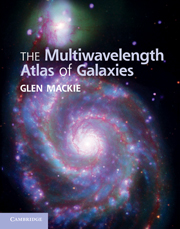Book contents
- Frontmatter
- Contents
- Preface
- Acknowledgements
- 1 Galaxies
- 2 Observing the electromagnetic spectrum
- 3 A view from the inside: The Galaxy
- 4 The Atlas, pages 67 to 153
- The Atlas, pages 153 to 218
- Appendices and references
- General text references
- Major image sources and references
- Selected references by galaxy
- Acknowledgements and permissions
- Galaxy index
- Index
Preface
Published online by Cambridge University Press: 05 June 2012
- Frontmatter
- Contents
- Preface
- Acknowledgements
- 1 Galaxies
- 2 Observing the electromagnetic spectrum
- 3 A view from the inside: The Galaxy
- 4 The Atlas, pages 67 to 153
- The Atlas, pages 153 to 218
- Appendices and references
- General text references
- Major image sources and references
- Selected references by galaxy
- Acknowledgements and permissions
- Galaxy index
- Index
Summary
In the early 1930s Karl Jansky detected the center of our Galaxy in radio waves at a wavelength of 14.6 m or a frequency of 20.5 MHz.
Until this time all observations of galaxies had been made in the optical region, which has radiation with wavelengths between 330 and 800 nanometers. Galaxies that can be seen by eye, appearing as faint, cloud-like objects, are the two Magellanic Clouds (named after the Portuguese explorer Ferdinand Magellan) in the southern hemisphere and the Andromeda Galaxy (NGC 224 or Messier 31) in the northern hemisphere. Observers with very good eyesight may also detect NGC 598/M 33, in the constellation Triangulum. We also get a myopic view of nearby stars (about 6000 within a few thousand light-years) and a wide-field view of diffuse light, “the Milky Way”, from distant stars, near the plane of our own Galaxy.
Since the early seventeenth century, telescopes have provided higher resolution observations to fainter brightness levels than possible with the eye. In 2009 the world celebrated the International Year of Astronomy (IYA), as sanctioned by the United Nations and directed by the International Astronomical Union partly to celebrate 400 years of telescopic observations since the initial endeavors of Thomas Harriot and Galileo Galilei.
In terms of effective galaxy research tools, we had to wait until the mid-nineteenth century for large telescopes to be built. Observations by eye, photography and by spectroscopy all played vital roles.
- Type
- Chapter
- Information
- The Multiwavelength Atlas of Galaxies , pp. ix - xPublisher: Cambridge University PressPrint publication year: 2011



